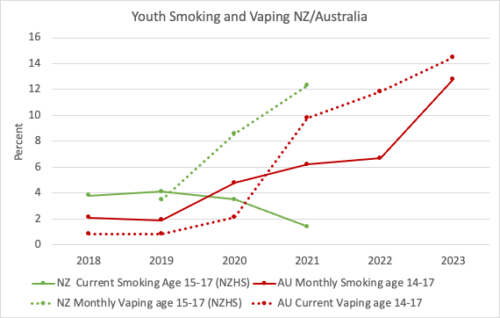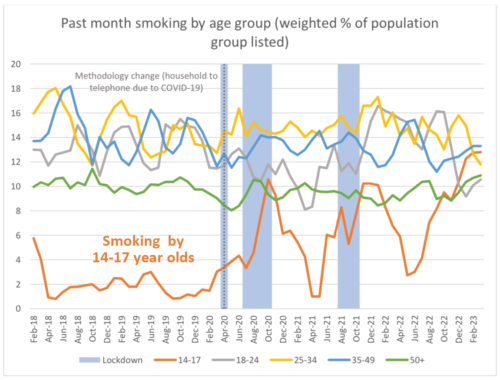
Tobacco Control fails to control tobacco then blames vaping
Posted on June 4, 2023 By Colin
A RECENT REPORT for the Department of Health and Ageing has found that Australia’s adult smoking rate has not declined over the last 5 years and youth smoking is on the rise. The government's solution? Crack down on vaping!
The report is based on a monthly Roy Morgan survey in 5 capital cities, recording past-month smoking and vaping over the last 5 years, for Australians aged 14+. The smoking rate was 11.8% in early 2023, although likely to be significantly higher in rural and remote areas.
Adult Smoking
The stalled adult smoking rate is a monumental public health policy failure
Despite the highest cigarette prices in the world, plain packaging and “world leading tobacco control”, there has been no decline in adult smoking over a 5-year period from 2018-2023.
This is even more disturbing when other western countries such as New Zealand, the UK and US are experiencing accelerated declines in smoking rates as a result of safer nicotine products, such as vaping.
For example, the adult smoking rate in New Zealand has galloped past Australia during this period, declining by an unprecedented by 33% from 2020-2022 alone, after vaping was legalised and regulated in August 2020.

Clearly we have got it wrong, But Butler’s minions simply keep repeating, “we need to crack down on vaping”. However, the public health imperative is to focus on reducing deadly smoking.
They can’t have it both ways. It is their model of vaping policy which has created this failure. Doubling down further will only make it worse!
What about the children?
Teen smoking in Australia reportedly rose from 2.1% in 2018 to 6.7% in 2022, after years of steady declines. Public health groups are in a sweat about “the 3-fold smoking increase”, which of course they blame on the rise in vaping.
Authorities claim without evidence that the rise in teen vaping has caused teen smoking to increase. If that is the cause, why has there been a decline in smoking in young adults, who have the highest vaping rates? There was a 21% decline in smoking in the 18-24 year age group (vaping rate 19.8%) and 17% decline in the 25-34 year age group (vaping rate 17.4%).
Furthermore, in other jurisdictions, such as New Zealand, the UK and US, increases in youth vaping are associated with an accelerated decline in youth smoking
For example, in New Zealand, youth vaping rates have increased (dotted green line) but there has been a marked decline in youth smoking rates (solid green line).

Australian authorities have engaged in a scare and misinformation campaign about vaping, exaggerating the risks. Is misinformation driving some young people to smoke instead? It certainly does not appear to have reduced vaping rates. Has Australia's flawed policy on vaping created a gateway to smoking, which doesn’t exist in other countries?
If the survey data are valid it is a clear indication that the current prescription-only vaping policy and misinformation campaign has been a disastrous failure. It has failed to prevent access to vapes by young people while at the same time has discouraged uptake by the people who need them most, older smokers.
Are the teen results valid?
In my view, claims that teen smoking has tripled in four years after years of decline are not credible and I expect future surveys and the upcoming National Drug Strategy Household Survey to verify that.
In the recent survey, the monthly teen smoking figures (orange line below) fluctuated wildly from one month to the next. Based on this volatility it could be down to 1-2% again next month.

The small number in the 14-17 year age group also make the results less reliable (only 3,800 out of the total of 70,300 surveyed). There are also a range of methodological issues in this study that undermine its validity.
Political motivation?
The motivation for releasing this report now seems suspiciously political. The unsubstantiated claims about vaping appear to be timed to demonise vaping to gain further support for Mark Butler’s proposed vape ban.
The National Drug Strategy Household Survey 2022 results should be released in early 2024 and are robust and detailed. In my view, this report is just a diversion.
The bottom line
If this survey is valid as the authorities say, it is a serious indictment of tobacco control in Australia. The failure to reduce smoking over a five year period is a national crisis
Organisations like QuitVic, PHAA and the AMA have tried to distract attention from this policy failure by a media blitz attacking vaping. Meanwhile adults are dying from smoking - 100,000 smokers have died during this 5-year study. Reducing tobacco smoking has to be the focus of tobacco control. Vaping nicotine could be a key part of the solution.
Resources